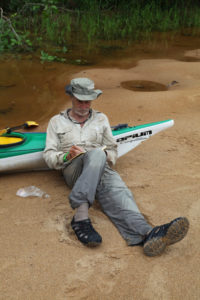Marc Meyers, Humboldt-Award winner and materials scientist originally from Brazil, was inspired to traverse the historical Roosevelt-Rondon-Expedition 100 years later. He will give a lecture on his adventures at July 30.
In 1914, after losing the election for a third term in presidential office, Theodore Roosevelt headed into the Brazilian Amazon...
From Sarah Puschmann
… for an adventure. He teamed up with his son Kermit, the Brazilian explorer Colonel Cândido Rondon, and nineteen other men to canoe down the River of Doubt whose course remained a mystery to the Western world. The trip wasn’t easy. The team fended off bumble-bee sized horseflies and blood-sucking borrachudo flies with “fly dope,” braved ants that stung with the ferocity of scorpions, and maneuvered through rapids. Three members of their expedition died en route and Roosevelt harbored a deep-seated fear that his son wouldn’t make it out alive. (Thankfully, Kermit survived.)
It is precisely this stretch of the Amazon what Roosevelt calls, “a land of unknown possibilites” that Marc Meyers, a materials scientist originally from Brazil, was inspired to traverse 100 years later. In 2014, Meyers set out with only three companions: two retired Brazilian Army colonels, Colonel Hiram and Colonel Angonese, as well as the American cinematographer Jeffrey Lehmann. Equipped with a compass, GPS, a 9 mm pistol and freeze-dried camping food, the team aimed to retrace Roosevelt’s journey with the goal of collecting specimens and observing the differences in the landscape and fauna since the former president had paddled there.
The trip — spanning a distance of nearly 1,200 km — got off to a rocky start. Meyers had had kayaks built for the journey in Brazil and shipped to the starting point, so he hadn’t gotten a chance to train with the boats in advance. “The first day, I flipped the kayak twice,” Meyers says. But the water with its swirling rapids and sudden waterfalls wasn’t the only threat: About a week into the first leg of the journey, the team was discovered by a motorboat full of members of the indigenous group the Cinta Larga as the team passed through the tribe’s territory. “I felt uneasy,” said Meyers, as the native people — equipped with shotguns — approached. Meyers’ team greeted the Cinta Larga people, who didn’t respond. When the team exited their boats they were accosted by the chief, who was outraged that the team had entered their land without consent. “Officially, we should have asked for permission. We tried to sneak through, you see,” Meyers says. The chief was also concerned. If anything happened to the team further down the river — if they were robbed or attacked — he would be held responsible. Attempts to diffuse the tension failed. Ultimately, the truck that was supposed to meet the team further down the river made a detour and picked them up, driving them out of Cinta Larga territory.
For the remaining month of the trip, as well as during the second month-long leg undertaken in 2015, Meyers collected feathers and coconuts, although exhaustion prevented him from the more comprehensive collection he’d anticipated. The trip did, however, provide another kind of scientific opportunity – inspiration: A square-stemmed liana he found in Nambikwara territory piqued Meyers’ long-standing curiosity about the occurrence of squares, a rare shape in nature. Although the liana vine itself was accidently discarded on the trip, the idea persisted post-journey and developed into findings about the central shaft of feathers, called the rachis, which in many flighted birds is circular at its base and then morphs into a square at its tip.
After winning the Humbolt Award and carrying out the first part of his grant at Karlsruhe Institute of Technology, Professor Meyers selected the INM – Leibniz Institute for New Materials in Saarbrücken as his host for the final two months of his grant. Meyers was drawn to the INM for its cutting edge research tools and innovative ideas, in particular to the Gecomer project led by INM Chairman of the Board Eduard Arzt, which features adhesive surfaces inspired by the way geckos stick to walls. “Being here has opened possibilities. The INM has fantastic analysis and characterization facilities,” says Meyers.
Now he is at work on gaining insight into another material mystery: why the teeth of the deep-sea dragonfish are transparent. But Meyers’ journey through the Brazilian Amazon isn’t over yet. In August, he’ll head off for the final leg of his journey: a 750 km trip up the Paraguay River by riverboat. The land of unknown possibilites, rife with danger and brimming with a thousand small joys , the taste of tart honey, the berry scent of orchids, the giant cicada’s train-whistle song, awaits.
Marc Meyers will give a lecture, “Down the river of Doubt: Celebrating the Roosevelt-Rondon Scientific Expedition on its Centennial” on June 30 at 11:00 am at INM , Leibniz-Saal, Campus D 2 5. Members of the public are welcome to attend.



